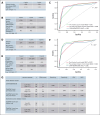Characterization and prediction of prolonged severe neutropenia in pediatric patients receiving tisagenlecleucel
- PMID: 40690779
- PMCID: PMC12516046
- DOI: 10.1182/bloodadvances.2025016824
Characterization and prediction of prolonged severe neutropenia in pediatric patients receiving tisagenlecleucel
Abstract
Hematotoxicity is the most frequent severe toxicity after chimeric antigen receptor T-cell (CAR-T) therapy. However, limited data exist on risk factors and outcomes for hematotoxicity for children and young adults (CAYAs) with B-acute lymphoblastic leukemia treated with tisagenlecleucel. We conducted a multi-institutional study involving 326 CAYAs, with 144 evaluable in an initial training cohort and 141 evaluable in a validation cohort, through the Pediatric Real-World CAR Consortium to characterize the incidence and outcomes of prolonged severe neutropenia (PSN) and to develop a predictive risk score for PSN, tailored for use in this population. The incidence of PSN, defined as an absolute neutrophil count of <0.5 x 103 cells per μL for ≥30 days, was 15.3% in the initial training cohort and 21% in the validation cohort. Development of PSN was associated with inferior overall survival (P < .001), relapse-free survival (P = .01), higher nonrelapse mortality (P = .003), and a greater risk of infections within 30 days (P = .03). Multivariable penalized regression analysis identified key risk factors for PSN, which included preinfusion C-reactive protein and bone marrow disease burden, and postinfusion peak ferritin and occurrence of severe cytokine release syndrome, which were used to create the CytoRisk score. In the validation cohort, the CytoRisk score discriminated between patients with and without PSN (area under the curve, 0.90; specificity, 93%; sensitivity, 71%; positive predictive value, 74%; and negative predictive value, 92%). The CytoRisk score may be used to a priori identify patients at highest risk of PSN and overall worse outcomes.
© 2025 American Society of Hematology. Published by Elsevier Inc. Licensed under Creative Commons Attribution-NonCommercial-NoDerivatives 4.0 International (CC BY-NC-ND 4.0), permitting only noncommercial, nonderivative use with attribution. All other rights reserved.
Conflict of interest statement
Conflict-of-interest disclosure: C.L.M. holds multiple patents related to chimeric antigen receptor (CAR) T-cell therapies; receives royalties for CD22-CAR from CARGO Therapeutics; holds equity in CARGO Therapeutics, Link Cell Therapies, GBM NewCo, and Ensoma; consults for CARGO Therapeutics, Link Cell Therapies, GBM NewCo, Ensoma, Immatics, and AstraZeneca; and receives research funding from Tune Therapeutics. R.H.R. has received honoraria from Novartis; and consulting fees from Pfizer. V.A.F. consults for Adaptimmune. T.W.L. holds equity in Advanced Microbubbles; consults for Bayer, Massive Bio, AI Therapeutics, Jazz Pharmaceuticals, GentiBio, ITM Oncologics, and GlaxoSmithKline; and receives research funding from Pfizer, Bayer, Turning Point Therapeutics, Lilly, Roche/Genentech, Taiho, Advanced Accelerator Applications/Novartis, BioAtla, Hoffman-La Roche, Exelixis, and Adaptimmune. The remaining authors declare no competing financial interests.
Figures





References
Publication types
MeSH terms
Substances
LinkOut - more resources
Full Text Sources
Research Materials

